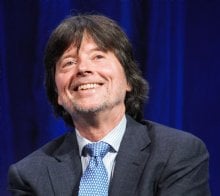"I record all of my music with authentic instruments in a studio before we start editing, doing many, many versions. The music shapes the film as we edit so it has an organic relationship to the content"
About this Quote
Ken Burns describes a filmmaking and music production process that values authenticity, depth, and a close interplay between sound and visuals. By insisting on recording all the music with real, "authentic" instruments, he underscores a refusal to rely on artificial or digital recreations, aiming instead for a sound that bears the nuances, textures, and emotional resonance of live performance. This preference suggests a commitment to capturing something genuine, evoking a sense of time, place, and atmosphere unmatched by synthetic sounds.
The notion of working in a studio before editing and producing "many, many versions" highlights a meticulous, exploratory approach. Rather than settling for a first draft or a single interpretation, Burns and his team try multiple takes, likely searching for the version that best aligns with the spirit and emotional truth of the material. This iterative process reflects a belief that music isn't just background filler but a living, evolving component of the storytelling, deserving the same refinement and creative attention as the visuals and narrative.
Most critically, Burns emphasizes that the music "shapes the film as we edit", introducing the idea of an "organic relationship" between sound and image. Rather than treating music as an afterthought added at the end of production, he weaves it into the fabric of the film from the earliest stages of editing. The evolution of the film and its score occur in tandem, each influencing the other. This dynamic approach allows the emotion, pacing, and rhythm of the documentary to respond authentically to the music and vice versa. The result is a more integrated, emotionally resonant work, where sound and picture collaborate to tell the story. Burns’s methodology affirms music’s power within film, not merely as accompaniment but as a co-author of meaning, mood, and experience.
More details
About the Author
